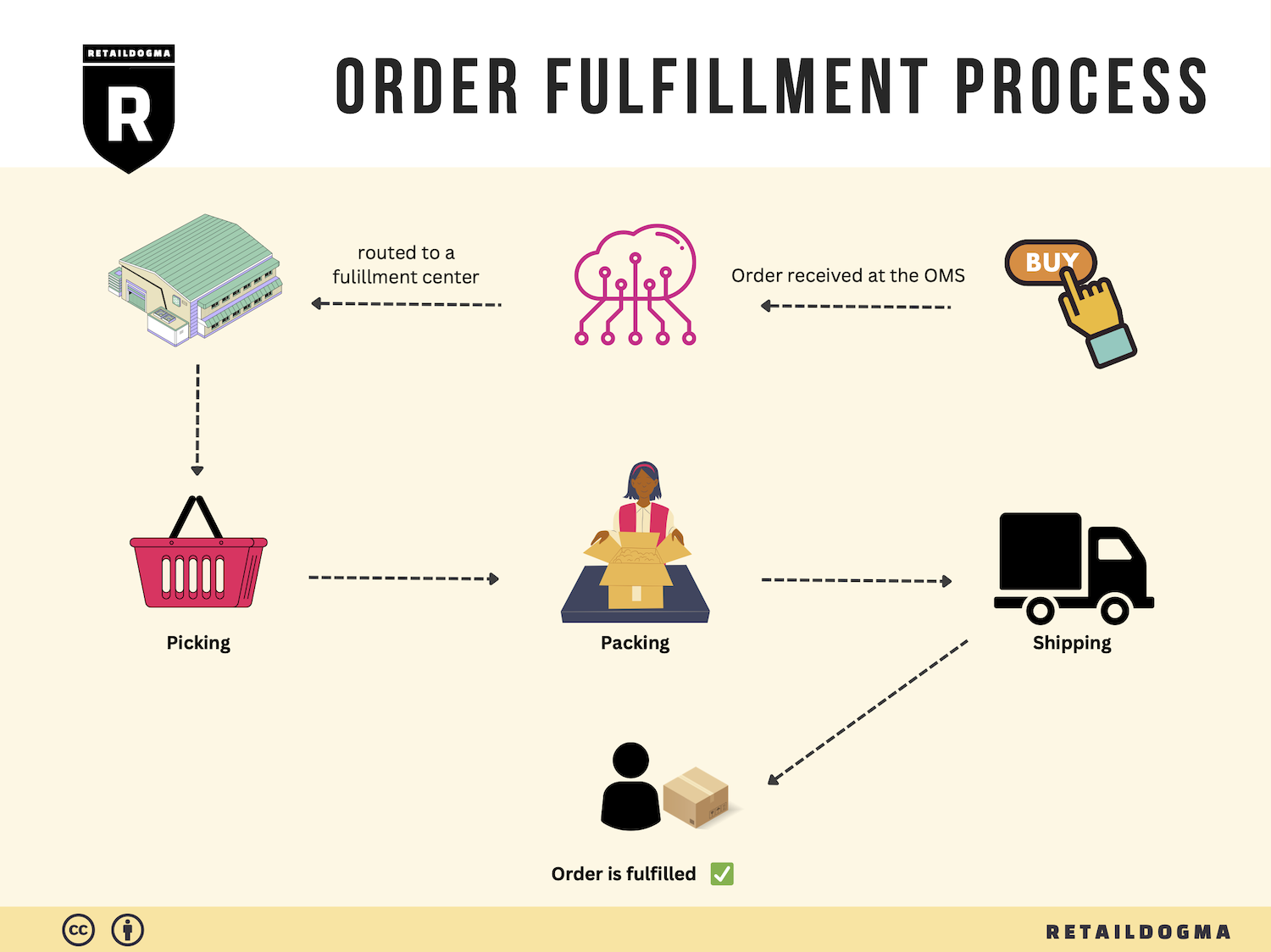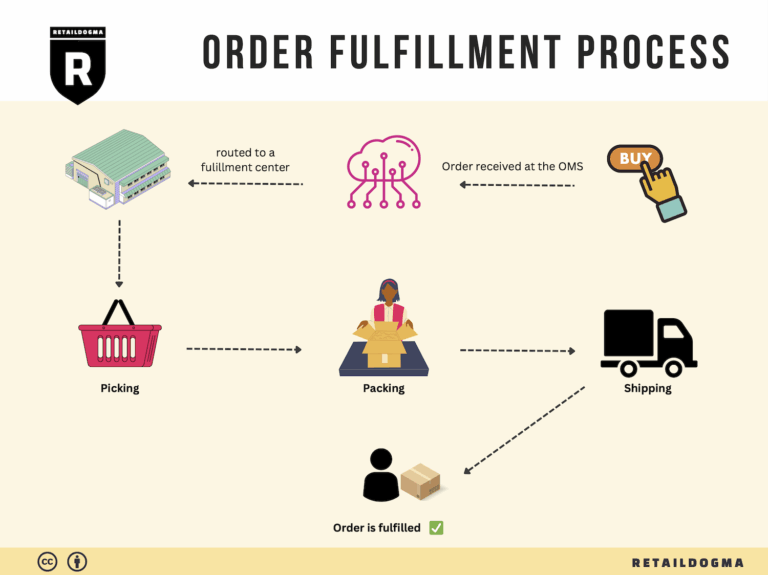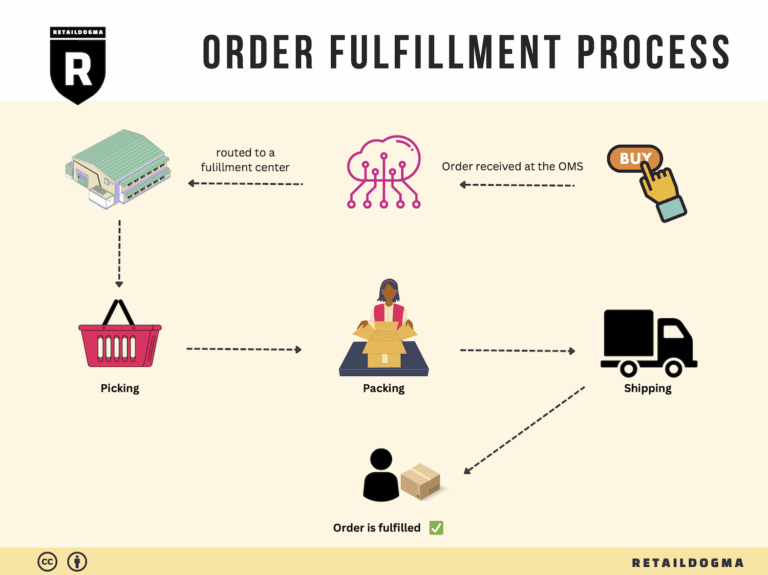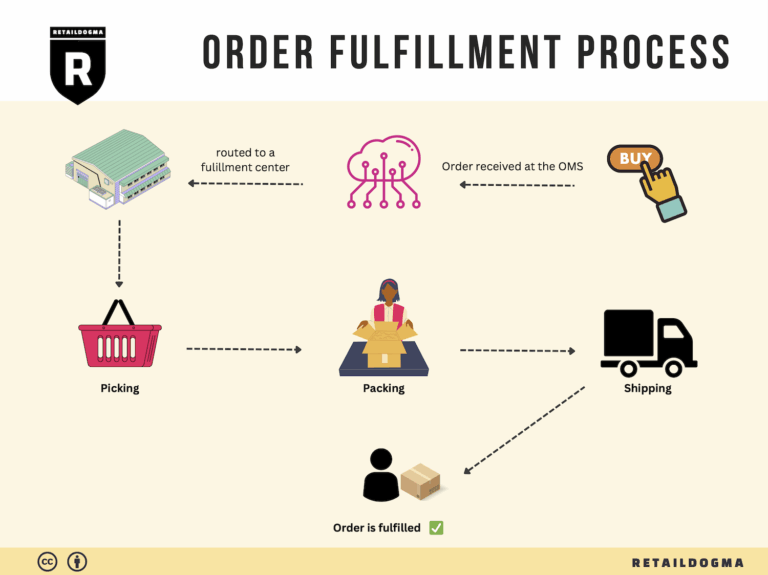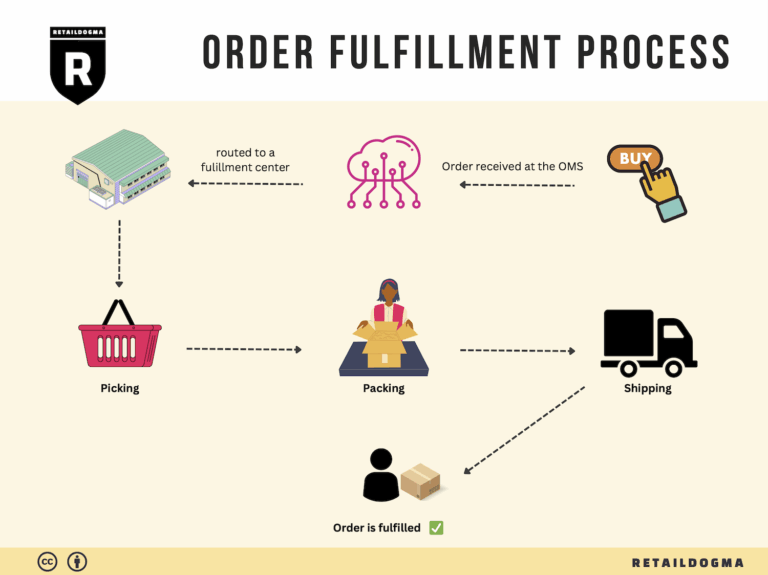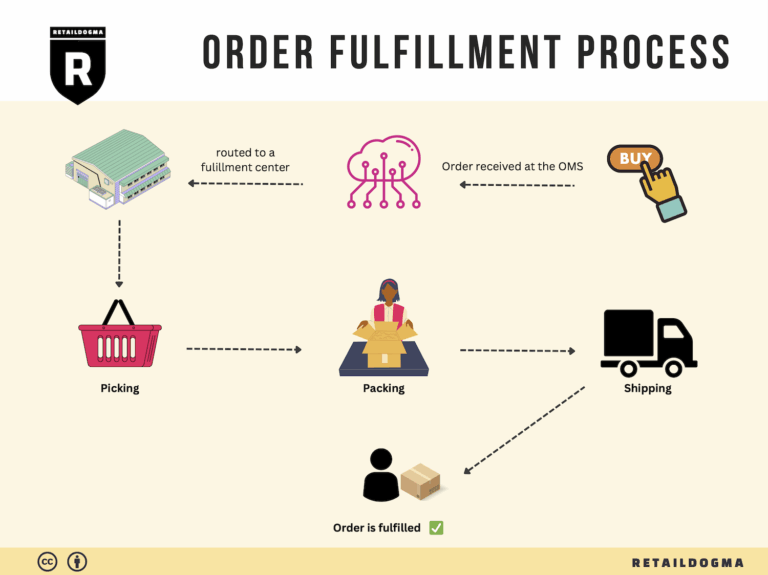How Order Fulfillment Works: A Step-by-Step Guide for Businesses
What is E-commerce Fulfillment? An Introduction for Growing Businesses
Understanding E-commerce Fulfillment
As an e-commerce business owner, you may find yourself grappling with a common challenge: managing the packing and shipping of orders. This task can quickly become overwhelming, especially during peak seasons or when scaling your operations. The good news is that you don’t have to handle it all alone. Understanding e-commerce fulfillment is crucial for relieving this burden and ensuring a seamless delivery experience for your customers.
Fulfillment, at its core, refers to the entire process of getting a product from your inventory to your customer’s doorstep. This involves several key steps: receiving inventory, storing products, processing orders, packing items, and shipping them out. For growing businesses, mastering this process can make all the difference between satisfied customers and logistical nightmares.
In this guide, we will explore various fulfillment models that can support your growth. You’ll learn about Third-Party Logistics (3PL) providers, which allow you to outsource storage, packing, and shipping tasks, and Fulfillment by Amazon (FBA), a popular option for leveraging Amazon’s extensive network to reach customers quickly. Each model has its advantages and considerations, and choosing the right one for your business is essential.
We’ll also delve into the core services associated with e-commerce fulfillment, such as inventory management, order processing, returns handling, and customer service. Understanding these services will help you identify what you need from a fulfillment partner to support your unique business model.
Choosing the right fulfillment partner is a critical step in your logistics strategy. We’ll guide you through the essential criteria to consider, including location, technology capabilities, reliability, and cost-effectiveness. By aligning your fulfillment strategy with your business goals, you can improve operational efficiency and enhance customer satisfaction.
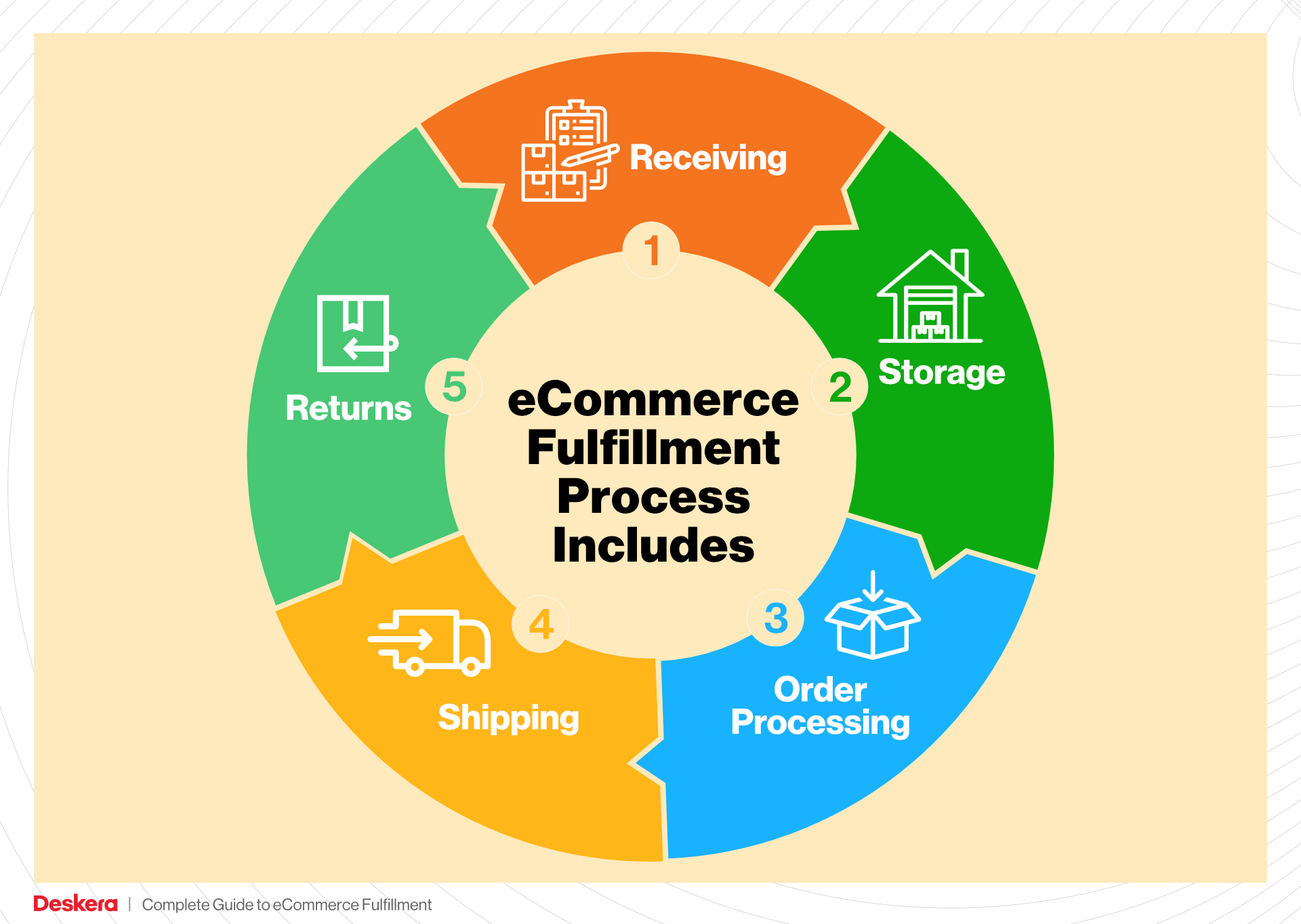
Finally, we’ll discuss pricing structures for fulfillment services, helping you navigate the costs involved and make informed financial decisions.
The goal of this guide is to empower you with the knowledge and insights necessary to make smart decisions about your logistics. By understanding e-commerce fulfillment, you can optimize your operations, reduce stress, and ultimately focus on what matters most: growing your business.
What You’ll Learn In This Guide
- What is E-commerce Fulfillment? An Introduction for Growing Businesses
- The Order Fulfillment Process: From ‘Buy’ Button to Customer’s Door
- Comparing Fulfillment Models: In-House vs. 3PL vs. Dropshipping
- A Deep Dive into Amazon FBA: Pros, Cons, and Who It’s For
- Core Services Offered by Fulfillment Centers
- How to Choose a Fulfillment Partner: A 6-Point Checklist
- Understanding Fulfillment Pricing: A Breakdown of Common Fees
- Frequently Asked Questions (FAQs) about Fulfillment
- Conclusion: Is Outsourcing Fulfillment the Right Move for Your Business?
- Important Disclaimer
The Order Fulfillment Process: From ‘Buy’ Button to Customer’s Door
1. Receiving Inventory
The first step in the order fulfillment process is receiving inventory. This involves accepting shipments from suppliers and manufacturers, verifying the contents against purchase orders, and inspecting for quality and damage.
This step is crucial because accurate inventory management lays the foundation for effective order fulfillment. If the inventory is not accurately received, it can lead to stock discrepancies, resulting in missed sales opportunities or customer dissatisfaction due to stockouts.
Key Term: SKU (Stock Keeping Unit)
Each product should have a unique SKU that helps in tracking inventory levels, managing reorders, and maintaining overall inventory accuracy.
2. Warehouse Storage
Once the inventory is received and verified, it is then organized in the warehouse during the warehouse storage phase. Products are typically stored based on their categories, demand, and size. High-demand items may be placed in easily accessible locations to expedite the picking process.
Efficient storage is vital for reducing the time it takes to fulfill orders. Poorly organized storage can lead to increased picking times and higher labor costs, which directly affect profitability and customer satisfaction.
Key Term: ABC Analysis
This inventory categorization technique prioritizes products based on their importance and sales volume, allowing businesses to optimize storage space and streamline picking processes.
3. Order Picking
The next step is order picking, where warehouse staff retrieve products from storage to fulfill customer orders. This is typically done using a pick list, which outlines the items and quantities needed for each order.
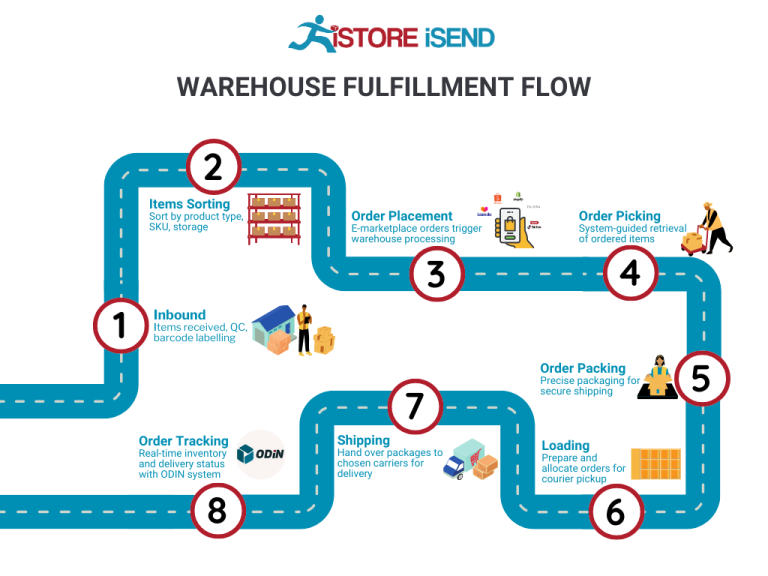
Order picking is critical because it directly impacts order accuracy and fulfillment speed. Efficient picking processes can significantly reduce the time from order placement to delivery, enhancing customer experience.
Key Term: Pick Lists
These documents or digital tools guide warehouse workers in selecting the correct items for each order, ensuring accuracy and efficiency.
4. Order Packing
After items are picked, they move to the order packing stage. Here, products are securely packaged to prevent damage during transit, and shipping labels are applied.
Effective packing is essential for minimizing returns due to damaged goods and ensuring that orders reach customers in good condition. It also provides an opportunity to include branding materials, such as thank-you notes or promotional inserts, which can enhance customer loyalty.
Key Term: Packing Slip
This document accompanies the order, detailing the items included, serving as a confirmation for customers and a reference for any potential returns or discrepancies.

5. Shipping & Delivery
The final step is shipping and delivery, where packed orders are handed over to carriers for transportation to the customer’s address. This phase includes choosing the appropriate shipping method based on speed, cost, and customer preferences.
Timely shipping and delivery are pivotal for customer satisfaction and retention. Delays can lead to negative reviews, lost sales, and damage to brand reputation. Therefore, businesses must have a reliable logistics network in place.
Key Term: Last-Mile Delivery
This term refers to the final step of the shipping process where the package is delivered to the customer’s doorstep. Optimizing this stage is crucial for ensuring that customers receive their orders promptly.
Conclusion
In summary, understanding and optimizing each step of the order fulfillment process—from receiving inventory to shipping and delivery—can significantly enhance operational efficiency and customer satisfaction. E-commerce businesses, especially those utilizing fulfillment centers like Amazon’s in Chicago, must ensure that these steps are streamlined and effective to maintain a competitive edge in the marketplace.
Comparing Fulfillment Models: In-House vs. 3PL vs. Dropshipping
Comparison of Fulfillment Models
| Model | Who Handles Inventory | Best For (Business Stage) | Key Advantage | Key Disadvantage |
|---|---|---|---|---|
| In-House Fulfillment | The business itself | Established businesses | Full control over inventory and operations | High upfront costs and resource-intensive |
| Third-Party Logistics (3PL) | A third-party provider | Growing businesses | Scalability and reduced operational burden | Less control over inventory and processes |
| Dropshipping | Suppliers | Startups and small businesses | Low initial investment and minimal risk | Lower profit margins and reliance on suppliers |
In-House Fulfillment
In-house fulfillment involves managing the entire logistics process within the business itself. This model is ideal for established companies that have a stable customer base and the resources to maintain their own warehousing and distribution operations. The primary advantage of in-house fulfillment is the complete control it offers over inventory management, order processing, and shipping operations. Businesses can implement their own quality control measures, customize their packaging, and ensure that their customer service aligns with their brand values.
However, the in-house model comes with significant disadvantages. The initial investment in warehouse space, equipment, and staffing can be substantial. Additionally, managing logistics requires a dedicated team and can divert focus from core business activities such as marketing and product development. As order volumes increase, businesses may find it challenging to scale operations without incurring additional costs.
Third-Party Logistics (3PL)
Third-party logistics (3PL) providers offer a flexible and scalable solution for businesses looking to outsource their fulfillment needs. This model is particularly beneficial for growing businesses that may not have the capacity or desire to manage logistics in-house. A 3PL handles everything from inventory storage to order fulfillment and shipping, allowing businesses to focus on their core competencies.
The key advantage of utilizing a 3PL is the ability to scale operations quickly without the overhead associated with managing fulfillment internally. Businesses can take advantage of the 3PL’s expertise, technology, and established networks to improve their logistics processes. However, the downside is that businesses relinquish some control over their inventory and fulfillment processes. This can lead to potential issues with order accuracy and customer service, especially if the 3PL does not align with the business’s operational standards or customer expectations.
Dropshipping
Dropshipping is a fulfillment model where the retailer does not keep goods in stock. Instead, when a customer makes a purchase, the retailer purchases the item from a third party (usually a wholesaler or manufacturer) and has it shipped directly to the customer. This model is particularly appealing for startups and small businesses that want to minimize initial investments and operational risks.
The primary advantage of dropshipping is the low barrier to entry. Retailers can offer a wide range of products without the need to invest in inventory upfront, making it an attractive option for entrepreneurs testing new markets or product lines. However, dropshipping comes with significant challenges. Profit margins are often lower due to wholesale pricing, and businesses are reliant on suppliers for inventory management and shipping. This can lead to issues with stock availability, shipping delays, and lack of quality control, which can ultimately affect customer satisfaction and brand reputation.
Conclusion
Each fulfillment model presents unique advantages and challenges that businesses must weigh based on their specific needs and growth stage. In-house fulfillment offers complete control but requires significant investment, while 3PL provides scalability and expertise at the cost of some operational control. Dropshipping is an excellent option for low-risk entry into e-commerce but may lead to lower profits and dependency on suppliers. By carefully considering their operational capabilities, customer expectations, and long-term goals, e-commerce business owners can choose the fulfillment model that best aligns with their strategic vision.
A Deep Dive into Amazon FBA: Pros, Cons, and Who It’s For
Understanding Fulfillment by Amazon (FBA)
Fulfillment by Amazon (FBA) is a service provided by Amazon that enables sellers to store their products in Amazon’s fulfillment centers. Amazon takes care of storage, packaging, shipping, and customer service, allowing sellers to focus on growing their business. When a customer orders a product, Amazon handles the entire order fulfillment process, including shipping the product directly to the customer.
FBA is designed to streamline the logistics of e-commerce, providing sellers with a robust platform to reach a larger audience while leveraging Amazon’s extensive infrastructure. Sellers can easily integrate their FBA inventory with their existing Amazon seller accounts, ensuring a seamless experience from inventory management to customer service.
How FBA Works
-
Setup and Inventory: Sellers create an Amazon seller account and enroll in the FBA program. They then send their products to Amazon’s designated fulfillment centers. Sellers must label their products according to Amazon’s guidelines before shipping.
-
Storage: Once the inventory arrives at the fulfillment center, Amazon takes over the storage. Sellers are charged storage fees based on the amount of space their products occupy.
-
Order Fulfillment: When a customer places an order, Amazon picks, packs, and ships the product. This process is automated, allowing for quick and efficient order processing.
-
Customer Service: Amazon also handles customer service inquiries and returns for FBA orders, which reduces the burden on sellers.
-
Payments: After the sale is completed, Amazon deducts its fees and transfers the remaining funds to the seller’s account.
Pros of Using FBA
Prime Eligibility
One of the standout benefits of FBA is that products fulfilled through Amazon are automatically eligible for Amazon Prime. This opens up a vast customer base that values fast and free shipping options. Prime members are more likely to make purchases, increasing sales potential for FBA sellers.
Customer Trust
Amazon is a trusted brand, and products fulfilled through FBA are often perceived as more reliable. Sellers can leverage this trust to enhance their brand reputation, as customers may be more inclined to purchase products backed by Amazon’s fulfillment service, knowing they have recourse in case of issues.
Multi-Channel Fulfillment
FBA is not limited to Amazon sales; it can also be used for fulfilling orders from other sales channels, such as eBay, Shopify, and Walmart. This flexibility allows sellers to centralize their inventory and streamline operations while still reaching customers across multiple platforms.
Cons of Using FBA
High Fees
FBA comes with a range of fees, including storage fees and fulfillment fees. These costs can add up quickly, particularly for sellers with slow-moving inventory or those selling larger items. It’s crucial for sellers to analyze their margins to ensure that FBA remains profitable.
Strict Inventory Rules
Amazon imposes strict guidelines regarding inventory management. Sellers must comply with regulations concerning product labeling, packaging, and shipping. Additionally, Amazon can charge long-term storage fees for items that do not sell within a specified time frame, putting pressure on sellers to maintain optimal inventory levels.
Commingling Risks
When sellers use FBA, their inventory may be commingled with that of other sellers. This means that identical products from different sellers are stored together, which can lead to potential issues. If a customer receives a defective or incorrect item, it can result in negative feedback for the seller, even if the issue arose from another seller’s inventory.
Who is FBA Best For?
FBA is particularly beneficial for:
- Small to Medium-Sized Sellers: Those who may not have the resources to manage their own logistics can benefit significantly from Amazon’s infrastructure.
- High-Volume Sellers: Sellers with a steady stream of orders can take advantage of the economies of scale that FBA provides, especially in terms of shipping and customer service.
- Sellers Looking to Scale: FBA allows sellers to expand their reach without the logistical headache of managing fulfillment themselves. By offloading this responsibility, sellers can focus on marketing and product development.
- Brands Seeking Trust: New brands looking to establish credibility in the market can leverage Amazon’s reputation to build customer trust quickly.
In conclusion, Fulfillment by Amazon offers a comprehensive logistics solution that can significantly enhance the operational efficiency of e-commerce businesses. However, it is essential for sellers to weigh the pros and cons carefully, considering their unique business needs and financial situations. By doing so, sellers can make informed decisions about whether FBA is the right fit for their growth strategy.
Core Services Offered by Fulfillment Centers
Inventory Management & Warehousing
Inventory management and warehousing are foundational services offered by fulfillment centers, essential for e-commerce businesses aiming to streamline their operations. This service involves the systematic tracking and storage of products to ensure that stock levels are optimized, thereby preventing overstocking or stockouts.
What It Is: Fulfillment centers utilize advanced inventory management systems to monitor stock levels in real-time. They receive, store, and manage inventory, ensuring that products are organized and easily accessible. This includes categorization by product type, SKU, or other relevant metrics, which facilitates efficient picking and packing.
Benefits: For e-commerce businesses, effective inventory management minimizes the risk of lost sales due to out-of-stock items and reduces the costs associated with excess inventory. By leveraging the warehousing capabilities of fulfillment centers, businesses can scale operations without the need for significant capital investment in their own storage facilities. Moreover, real-time inventory tracking provides valuable insights into sales trends and consumer demand, enabling businesses to make informed purchasing decisions.
Pick and Pack Services
Pick and pack services are critical for the timely fulfillment of customer orders. This process entails selecting (picking) the right products from the warehouse and preparing them (packing) for shipment.
What It Is: When a customer places an order, fulfillment center staff pick the items from the shelves, carefully ensuring accuracy and quality. The items are then packed using appropriate materials to protect them during transit. Many fulfillment centers also offer custom packaging options that can enhance branding and customer experience.
Benefits: This service significantly accelerates order processing times, which is crucial in today’s competitive e-commerce landscape. Fast and accurate picking and packing lead to shorter delivery times, enhancing customer satisfaction and increasing the likelihood of repeat purchases. Additionally, outsourcing these tasks allows e-commerce businesses to focus on core activities such as marketing and product development, rather than the logistical challenges of order fulfillment.
Kitting and Assembly
Kitting and assembly involve the preparation of products by bundling multiple items together or assembling components into a final product. This service is particularly beneficial for businesses that sell products requiring assembly or that offer bundled deals.
What It Is: In this process, fulfillment centers can take individual components or products and combine them into a single kit or assembled unit. For instance, a company selling a DIY furniture kit may require the assembly of various parts before shipping. Kitting can also involve packaging items together for promotional offers, such as a gift set.
Benefits: Kitting and assembly streamline the order fulfillment process by allowing businesses to offer unique product combinations without needing to manage complex inventories. This can lead to increased sales through bundled offerings and can enhance customer satisfaction by providing ready-to-use products. Furthermore, it reduces handling time during the picking and packing phases, as the fulfillment center can ship complete kits directly to customers.
Returns Management (Reverse Logistics)
Returns management, or reverse logistics, is a crucial aspect of e-commerce fulfillment that deals with the process of handling returned products. This service is vital for maintaining customer satisfaction and operational efficiency.
What It Is: Returns management involves the systematic handling of products that customers send back. Fulfillment centers process returns by inspecting items, restocking them if they are in sellable condition, or managing repairs or disposal if necessary. They also handle the associated paperwork and customer communication regarding returns.
Benefits: An efficient returns management system can significantly enhance customer loyalty, as easy return processes are a key factor in customer satisfaction. For e-commerce businesses, this service helps mitigate losses from returns by ensuring that products are quickly assessed and reintroduced into inventory when possible. Furthermore, effective reverse logistics can provide valuable data insights into product performance and customer preferences, helping businesses make informed decisions about their offerings and inventory management.
By leveraging the core services offered by fulfillment centers, e-commerce businesses can enhance operational efficiency, improve customer satisfaction, and ultimately scale their sales more effectively. These services allow businesses to focus on growth while ensuring that logistics and fulfillment are handled by experts in the field.
How to Choose a Fulfillment Partner: A 6-Point Checklist
Location & Warehouse Network
Choosing a fulfillment partner with strategically located warehouses is crucial for optimizing shipping times and costs. A partner with a robust network allows you to reach your customers faster, which can lead to improved customer satisfaction and retention.
Questions to Ask:
– Where are your fulfillment centers located, and how do those locations align with my customer base?
– What is your average shipping time to key regions?
– Do you have the ability to store inventory closer to major metropolitan areas to facilitate faster delivery?
Technology & Integrations
In today’s e-commerce landscape, technology plays a pivotal role in streamlining operations. A fulfillment partner should offer advanced technology solutions that integrate seamlessly with your existing systems (e.g., e-commerce platforms, inventory management tools).
Questions to Ask:
– What technology platforms do you use for order processing and inventory management?
– Can your system integrate with my e-commerce platform (Shopify, Amazon, WooCommerce, etc.)?
– How do you ensure data accuracy and real-time tracking for orders?
Specializations (e.g., Cold Storage, Oversized Items)
Different products have unique fulfillment requirements. If your business involves specialized items such as perishable goods or oversized products, it’s essential to partner with a fulfillment center that has the necessary capabilities and expertise.
Questions to Ask:
– Do you have facilities for specialized storage needs (e.g., cold storage for perishables)?
– How do you handle oversized or heavy items?
– What processes do you have in place to ensure the safe handling and storage of delicate items?
Scalability & Capacity
As your business grows, your fulfillment needs will likely change. It’s important to select a partner that can scale operations in line with your growth trajectory without compromising service quality.
Questions to Ask:
– What is your current capacity, and how do you manage peak seasons or increased order volumes?
– Can you accommodate seasonal fluctuations in inventory and order volume?
– What are your plans for expansion or upgrades in your warehouse facilities?
Pricing and Contracts
Understanding the pricing structure and contract terms is vital for budgeting and ensuring that your fulfillment costs align with your business model. Look for transparency in pricing, and be wary of hidden fees.
Questions to Ask:
– What is your pricing model (per order, per item, storage fees, etc.)?
– Are there any additional fees for services such as returns, packaging, or special handling?
– What are the terms of the contract, and is there flexibility for renegotiation as my business evolves?
Customer Support & Reviews
A fulfillment partner’s customer support can significantly affect your operations. Responsive and knowledgeable support can help resolve issues quickly, minimizing downtime and disruptions in service.
Questions to Ask:
– What customer support channels do you offer (phone, email, chat)?
– What is your average response time for customer inquiries or issues?
– Can you provide references or reviews from other businesses in my industry?
Conclusion
Choosing the right fulfillment partner is a critical decision that can impact your e-commerce business’s efficiency and customer satisfaction. By considering these six key areas—location, technology, specializations, scalability, pricing, and support—you can make an informed choice that aligns with your business goals. Always take the time to conduct thorough research and ask the right questions to ensure that your chosen partner will contribute positively to your growth and operational success.
Understanding Fulfillment Pricing: A Breakdown of Common Fees
Initial Setup Fees
When partnering with a fulfillment center, many providers charge an initial setup fee to cover the costs associated with onboarding your business. This fee typically includes account setup, integration with your e-commerce platform, and initial training for your team. The amount can vary widely, often ranging from $100 to several thousand dollars, depending on the complexity of your operations and the specific requirements of the fulfillment service.
To calculate these fees, providers may assess the number of SKUs you plan to manage, the volume of orders you expect, and any additional services you may require, such as customized packaging or branding. It’s essential to clarify what the setup fee includes to avoid unexpected costs later.
Receiving Fees
Receiving fees are charged when your inventory arrives at the fulfillment center. This fee covers the labor and equipment needed to unload, inspect, and store your products. Typically, these fees are calculated based on the number of pallets or bins you send. For example, a fulfillment center might charge $20 per pallet or $5 per bin received.
It’s important to be aware that some fulfillment centers may have minimum receiving fees, which means that even if you send a small shipment, you will still be charged a base rate. Understanding the receiving process and the associated fees can help you manage your inventory more effectively and reduce costs.
Storage Fees (per pallet/bin)
Storage fees are incurred for keeping your products in the fulfillment center’s warehouse. These fees are usually charged on a monthly basis and can be calculated per pallet or per bin. For instance, a typical storage fee might be $10 to $30 per pallet per month, depending on the location and demand for space.
Storage fees can also vary based on the time of year; peak seasons (like the holidays) may lead to higher rates due to increased demand for storage space. Additionally, some fulfillment centers may charge long-term storage fees for items that remain in the warehouse for extended periods, often defined as six months or more. To manage these costs, regularly assess your inventory turnover and consider strategies to minimize excess stock.
Pick & Pack Fees (per item/order)
Pick and pack fees are charged for the labor involved in selecting items from your inventory and packaging them for shipment. These fees can be structured in various ways, typically ranging from $0.50 to $2.00 per item or $1.00 to $3.00 per order. The pricing structure can depend on the complexity of the order, such as whether multiple items need to be picked or if special packaging is required.
Understanding how pick and pack fees are calculated is crucial for budgeting your fulfillment costs. To minimize these fees, consider optimizing your product listings and inventory organization to facilitate quicker picking processes. Additionally, consolidating orders can help reduce the number of separate pick and pack charges.
Shipping Fees
Shipping fees are one of the most significant costs associated with fulfillment. These fees are determined by various factors, including the shipping method (standard, expedited, or same-day), package weight, dimensions, and the destination. Most fulfillment centers provide discounted shipping rates through partnerships with major carriers, which can save you money compared to retail shipping rates.
To calculate shipping fees, fulfillment centers typically use a tiered pricing model based on weight brackets. For example, a package weighing between 1-5 pounds might incur a specific rate, while heavier packages will fall into a higher bracket. It’s crucial to understand how these fees are structured, as they can vary significantly between providers.
Tips for Getting an Accurate Quote
-
Detail Your Needs: When requesting quotes, provide detailed information about your business model, including the number of SKUs, expected order volumes, and specific service requirements. The more details you provide, the more accurate your quote will be.
-
Compare Multiple Providers: Don’t settle for the first quote you receive. Compare several fulfillment centers to assess their pricing structures, services offered, and customer reviews. This will help you identify the best fit for your business.
-
Ask About Hidden Fees: Inquire about any additional fees that might not be included in the initial quote, such as long-term storage fees, returns processing fees, or surcharges during peak seasons.
-
Negotiate Terms: If you find a fulfillment center that meets your needs, don’t hesitate to negotiate terms or ask for discounts, especially if you expect high order volumes.
-
Consider Flexibility: Choose a fulfillment partner that offers flexible pricing models to adapt to your business growth. This can help you avoid unexpected costs as your order volume fluctuates.
By understanding these common fulfillment pricing models and following these tips, you can effectively manage your logistics costs and ensure a smooth partnership with your chosen fulfillment center.
Frequently Asked Questions (FAQs) about Fulfillment
1. What is an Amazon Fulfillment Center?
An Amazon Fulfillment Center is a large warehouse where Amazon stores products sold by third-party sellers. When a customer places an order, Amazon picks, packs, and ships the items directly from these centers, allowing for quick delivery and efficient inventory management.
2. How does fulfillment work at the Amazon Fulfillment Center in Chicago?
At the Chicago Fulfillment Center, products are stored until an order is placed. Once an order is received, Amazon associates pick the items from the shelves, pack them securely, and ship them directly to the customer. This process is designed to ensure speed and accuracy, with advanced technology facilitating inventory tracking and order processing.
3. What is the difference between a warehouse and a fulfillment center?
A warehouse primarily serves as a storage facility for goods, while a fulfillment center focuses on processing and shipping orders to customers. Fulfillment centers are equipped with technology and staff trained to pick, pack, and ship products efficiently, often providing additional services like returns management.
4. What is a Third-Party Logistics Provider (3PL)?
A Third-Party Logistics Provider (3PL) is a service that handles logistics operations on behalf of a business. This includes warehousing, inventory management, order fulfillment, and shipping. Using a 3PL allows businesses to outsource these functions, enabling them to focus on core activities such as marketing and product development.
5. How much do fulfillment services cost?
Fulfillment service costs can vary significantly based on factors such as order volume, storage needs, and specific services required (like kitting or custom packaging). Generally, you can expect to pay for storage space, picking and packing fees, and shipping costs. It’s advisable to request quotes from multiple providers to compare pricing structures.
6. How quickly can I expect orders to be fulfilled at the Chicago center?
Amazon Fulfillment Centers typically process orders quickly, often within hours. Many orders shipped from the Chicago facility can benefit from 1- or 2-day shipping options, depending on the customer’s location and the shipping method chosen.
7. Can I use my own branding with Amazon Fulfillment?
Yes, while Amazon handles the fulfillment, sellers can often include branded packaging and inserts in their shipments. However, it’s essential to comply with Amazon’s policies regarding branding and packaging to avoid potential issues.
8. What types of products can be fulfilled at the Amazon Fulfillment Center?
Amazon Fulfillment Centers can handle a wide range of products, including non-perishable items, electronics, clothing, and household goods. However, there are restrictions on hazardous materials, perishables, and items requiring refrigeration. Always check Amazon’s guidelines to ensure compliance.
9. How does Amazon handle returns from the fulfillment center?
Returns processed through Amazon Fulfillment Centers are typically managed through their automated system. When a customer initiates a return, the fulfillment center receives the item back, inspects it, and restocks it if it’s in sellable condition. The seller is notified of the return, and the inventory is adjusted accordingly.
10. What are the benefits of using Amazon Fulfillment Centers for my e-commerce business?
Using Amazon Fulfillment Centers offers several advantages, including access to Amazon’s extensive logistics network, faster shipping times, improved order accuracy, and the ability to reach a broader customer base. Additionally, leveraging Amazon’s brand recognition can enhance customer trust and potentially increase sales.
Conclusion: Is Outsourcing Fulfillment the Right Move for Your Business?
Evaluating the Benefits of Outsourcing Fulfillment
Outsourcing your fulfillment operations can be a transformative decision for your e-commerce business, especially as you look to scale. One of the most significant benefits is time savings. By delegating order processing, inventory management, and shipping logistics to a dedicated fulfillment partner, you can focus on core business activities such as marketing, product development, and customer engagement. This strategic allocation of resources allows for enhanced productivity and innovation.
Scalability is another crucial advantage. As your business grows, so too does the complexity of your logistics. A fulfillment service can seamlessly scale with your operations, accommodating fluctuations in order volume, seasonal demands, and new product launches. This flexibility ensures that you can meet customer expectations without the burden of overhauling your internal processes or infrastructure.
Furthermore, partnering with an experienced fulfillment provider brings specialized expertise. These organizations typically have established systems, technology, and best practices that can significantly enhance order accuracy and delivery speed. For instance, services like those offered by fulfillment centers in Chicago can provide 1- to 2-day shipping options, ensuring that your customers receive their orders promptly, which is crucial for maintaining a competitive edge.
Choosing the Right Partner for Growth
However, it’s essential to choose the right fulfillment partner. Conducting thorough research and due diligence is vital to ensure that the provider aligns with your business goals and can meet your specific needs. Look for partners that offer transparency, reliable performance metrics, and a proven track record of success.
Take Action
To determine whether outsourcing fulfillment is the right next step for your business, consider conducting a thorough audit of your current shipping process. Assess your fulfillment efficiency, customer satisfaction levels, and operational costs. This analysis will empower you to make an informed decision about whether a fulfillment partner could enhance your business operations and drive growth. Don’t leave your logistics to chance—take the proactive steps necessary to optimize your e-commerce strategy today.
Important Disclaimer
⚠️ Important Disclaimer
The information in this guide is for educational purposes. Fulfillment services, pricing, and platform features change frequently. Always conduct your own due diligence and consult with providers directly before making business decisions.
